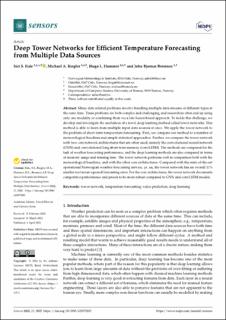| dc.contributor.author | Eide, Siri Sofie | |
| dc.contributor.author | Riegler, Michael | |
| dc.contributor.author | Hammer, Hugo Lewi | |
| dc.contributor.author | Bremnes, John Bjørnar | |
| dc.coverage.spatial | Norway | en_US |
| dc.date.accessioned | 2022-09-28T13:13:27Z | |
| dc.date.available | 2022-09-28T13:13:27Z | |
| dc.date.created | 2022-04-19T19:46:14Z | |
| dc.date.issued | 2022-04-06 | |
| dc.identifier.citation | Sensors. 2022, 22 (7), . | en_US |
| dc.identifier.issn | 1424-8220 | |
| dc.identifier.uri | https://hdl.handle.net/11250/3022319 | |
| dc.description.abstract | Many data related problems involve handling multiple data streams of different types at the same time. These problems are both complex and challenging, and researchers often end up using only one modality or combining them via a late fusion based approach. To tackle this challenge, we develop and investigate the usefulness of a novel deep learning method called tower networks. This method is able to learn from multiple input data sources at once. We apply the tower network to the problem of short-term temperature forecasting. First, we compare our method to a number of meteorological baselines and simple statistical approaches. Further, we compare the tower network with two core network architectures that are often used, namely the convolutional neural network
(CNN) and convolutional long short-term memory (convLSTM). The methods are compared for the task of weather forecasting performance, and the deep learning methods are also compared in terms of memory usage and training time. The tower network performs well in comparison both with the meteorological baselines, and with the other core architectures. Compared with the state-of-the-art operational Norwegian weather forecasting service, yr.no, the tower network has an overall 11% smaller root mean squared forecasting error. For the core architectures, the tower network documents competitive performance and proofs to be more robust compared to CNN and convLSTM models. | en_US |
| dc.language.iso | eng | en_US |
| dc.publisher | MDPI | en_US |
| dc.relation.ispartofseries | Sensors;Volume 22 / Issue 7 | |
| dc.rights | Navngivelse 4.0 Internasjonal | * |
| dc.rights.uri | http://creativecommons.org/licenses/by/4.0/deed.no | * |
| dc.subject | Tower networks | en_US |
| dc.subject | Temperature forecasting | en_US |
| dc.subject | Video predictions | en_US |
| dc.subject | Deep learning | en_US |
| dc.title | Deep Tower Networks for Efficient Temperature Forecasting from Multiple Data Sources | en_US |
| dc.type | Peer reviewed | en_US |
| dc.type | Journal article | en_US |
| dc.description.version | publishedVersion | en_US |
| dc.rights.holder | © 2022 by the authors | en_US |
| cristin.ispublished | true | |
| cristin.fulltext | original | |
| cristin.qualitycode | 1 | |
| dc.identifier.doi | https://doi.org/10.3390/s22072802 | |
| dc.identifier.cristin | 2017715 | |
| dc.source.journal | Sensors | en_US |
| dc.source.volume | 22 | en_US |
| dc.source.issue | 7 | en_US |
| dc.source.pagenumber | 1-18 | en_US |
| dc.relation.project | Meteorologisk institutt: 181040 | en_US |

